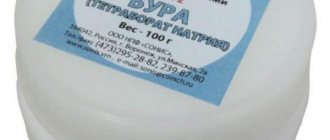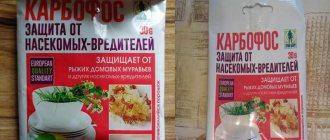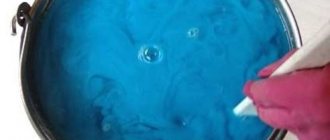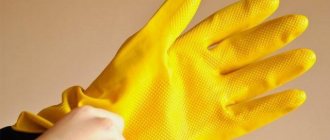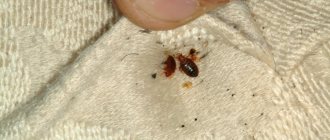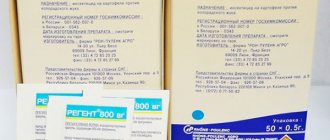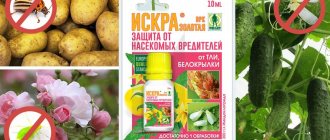Karbofos composition and action
The insecticide contains the main active ingredient – malathion. Its content in the product can vary from 10 to 50%. There is a fragrance - for smell, a filler and, of course, a surfactant.
It is thanks to the flavoring agent that Karbofos has such an unpleasant and repulsive odor. Which, by the way, is good in terms of preventing accidental poisonings.
Photo of the drug Karbofos
Purpose
Both independently and as part of other drugs “Karbofos” / “Malathion” the following is used:
- in agriculture to combat harmful insects, mites and stock pests;
- in medical and sanitary practice (as an anti-pediculosis remedy for nits and lice);
- for household disinfestation against synanthropic insects (ants, bedbugs, cockroaches, woodlice, etc.)
Operating principle of Karbofos
The insecticide Karbofos has an enteric contact action, that is, poisoning of the pest begins from the moment the active substance penetrates inside the bug. At the same time, Karbofos acts both when it comes into contact with the outer surface of the body and inside the gastrointestinal tract.
The pest dies after 3–4 hours.
Attention:
Very frequent treatments with the drug can lead to the development of resistance in pests to the product.
Operating principle
The insecticidal-acaricidal drug acts by contact-intestinal route. It penetrates into the body of domestic cockroaches through the chitinous cover and respiratory organs. Karbofos disrupts the functions of the central nervous system. A few minutes after contact with the poison, muscle paralysis and death occur.
The maximum effect lasts 4 hours. During this time, sexually mature and immature individuals die. The eggs in the ooteca continue to develop, but after the larvae hatch, they also die. Karbofos retains toxic properties indoors for up to 4 weeks.
On a note!
If the apartment is heavily infested, it is recommended to carry out repeated disinsection after 14 days to increase the concentration of the drug.
Karbofos is resistant to temperature and light, and is neutralized gradually. An acidic and alkaline environment can eliminate poison. When performing wet cleaning, add vinegar or soap or baking soda to the water.
Purpose and areas of use
Karbfos has a fairly wide range of applications. Here are just a few insect pests against which it is recommended to use this product:
- aphid;
- black garden ants;
- kidney mites;
- red ants that appear in houses;
- cockroaches;
- bedbugs;
- and others.
Photos of Karbofos release forms
Where can Karbofos be used:
- compact garden plots and even entire farms;
- treatment of residential buildings for disinfection purposes;
- sanitary and medical disinfection against lice, malaria carriers, etc.;
- warehouse processing of the drug;
- destruction of exo- and endoparasites in the field of veterinary medicine.
It is necessary to keep in mind that it is necessary to carry out 2 to 3 treatments with Karbofos throughout the year. It is no longer recommended, since an enzyme is formed in the body of insects that destroys the structure of the main substance of the drug.
Mechanism of action
The drug has a complex effect, which allows you to achieve maximum results. After treatment, the substance acts through the respiratory system; in addition, when in contact with the drug, the cockroach becomes infected with poison, which penetrates the chitinous shell. The active substances act directly on the nervous system, the insect is paralyzed and then it dies.
After the surfaces are treated, the maximum activity of the drug occurs within 4 hours. Then it begins to gradually decrease, but the toxic properties persist for 4 weeks. Adults and larvae die first, the eggs remain untouched. But thanks to the long action, all the emerging young individuals also die.
External factors such as light and temperature do not reduce activity. In order to neutralize the effect of the poison, it is necessary to use alkali in the form of soap solutions, or acid in the form of a solution with vinegar. If the apartment is heavily infested, then to achieve maximum results it is recommended to repeat the procedure after about 2 weeks.
Features of application
This product must be present in every garden plot. This is due to the fact that approximately 90% of pests that can appear in the garden can be eliminated using the Karbofos working solution.
Its peculiarity is that it is a disinfectant, which at the same time helps to improve the quality of the fruit. The soil is not damaged. It is only necessary to follow the consumption rates specified in the instructions for use of Karbofos. Each culture has its own.
Additionally, Karbofos fights gallicia, copperhead, weevil, whitefly, etc.
Attention:
By eliminating pests, Karbofos can harm and even destroy beneficial insects. It negatively affects pollination because pollinating insects also die as a result of the treatment. To avoid this, you should always remember the “golden rule” of working with Karbofos: never treat crops during flowering.
Karbofos. Instructions for Use - video
How the drug works
Using the product is convenient and simple, since the active substance destroys a number of harmful insects and parasites.
- Getting directly onto the insect's body, the insecticide destroys it. If the beetles are under leaves or in the ground, their survival rate increases significantly.
- The active substance instantly kills pests.
- Under the influence of various climatic and physical factors, chemical properties are lost. In open areas, in the garden in summer, the substance remains effective for up to 10 days, and in enclosed spaces - 7 days.
When treating surfaces and plants with Karbofos, beetles die en masse. But constant use of the substance is addictive and requires replacement with other drugs.
Protection against garden pests
Ants are one of the most annoying and difficult to remove insects in the garden. As a preventative measure to protect the garden from ants, take 30 grams of Karbofos per amount of water from 3 to 5 liters.
Treatment method:
spraying onto the anthills themselves.
Be sure to treat tree trunks in the same way. Pests in the garden!
Cutworm Wireworm Mole
cricket Additionally, to enhance the effect, sprinkle the powder in those places where there is a particularly large concentration of ants, as well as on the paths along which they most often move. Process no more than 2 times.
To treat fruit, berry and vegetable crops with Karbofos, it is recommended to use irrigation or the same spraying as described in the fight against garden ants. Process twice. Between treatments it is necessary to leave a gap of at least three to four weeks. The first treatment is recommended in early March, when the buds have not even formed, and the second – after the crop has finished flowering.
Is it possible to use insecticide against cockroaches and mosquitoes?
Karbofos is productive for killing mosquitoes and cockroaches. To carry out the procedure, it is important to use a spray bottle so that the substance can reach even the most inaccessible places, especially behind baseboards and furniture.
When processing, safety and caution play a significant role. It is necessary to use protective equipment: wear closed clothing so that the substance does not come into contact with the skin.
After the procedure is completed, these clothes will be thrown away; you should think about this in advance. Wear protective goggles and a mask over the eyes to protect the face from allergies and avoid intoxication.
At the very end of the manipulation, you should wash your hands with soap and water and ventilate the room after four hours until the smell goes away. Wet cleaning of the room is carried out later; soap and other chemicals kill the effect of the insecticide completely.
This product should not be used for a long time, as cockroaches have the ability to adapt to chemicals.
Let's watch a video about using karbofos to fight cockroaches:
Consumption rates of Karbofos for various crops (melatonin content 10%)
Different crops require their own dosage of the drug. Here are the consumption rates for Karbofos with a 10% melatonin concentration.
Karbofos against pests of peach and apricot
Typical pests of these crops are codling moths and leaf rollers. To eliminate pests, I take 30 grams of insecticide per 5 liters of water.
Photo of fruit path on apricot
For quince, pear, apple trees
To eliminate weevils, codling moths, scale insects, and leaf rollers, you will need 60 grams per 7 liters of clean water. 2 liters of water is enough for a young tree, and up to 10 liters for an adult.
Photo of fruit on an apple
Karbofos against pests of peppers, cucumbers, tomatoes
Karbofos is also often used for tomatoes, cucumbers and peppers, which have their favorite pests. For example, aphids on cucumbers can seriously poison the life of any gardener.
In addition to aphids, these crops can also be affected by plant mites, white mites, and flies. For the solution, 30 grams of product per 5 liters of water is enough. A liter of working solution is enough to treat 10 m2.
Karbofos against aphids! Great result - video
For grapes
30 grams of Karbofos per amount of clean water from 3 to 4 liters is enough to eliminate mealybugs, phylloxera, and spider mites. Per 10 m2 there are from 1 to 1.5 liters of fresh solution.
Interesting article:
Fungicides for grapes
Karbofos for currants and other berry bushes
For bud mites, annoying aphids on currants and gall midges, you will need 30 grams of Karbofos per 4 liters of water.
Interesting article:
Proper care of currants in the fall and preparation for winter
One berry bush usually requires from 10 to 20 liters.
For melons
It is enough to dilute 30 grams of the drug in 4 liters of water to remove aphids, melon beetles, and melon flies. To treat an area of 10 m2 you will need from 1 to 1.5 liters.
Treatment of indoor and garden flowers with karbofos
Flowers are treated no less often than vegetables.
The active substance it contains will protect against:
- bedbugs;
- aphids;
- sawfly;
- spider mite.
Both garden and indoor plants feel great when the established drug consumption rates and the required amount of water are strictly observed.
INTERESTING TO KNOW!
The best fertilizers for indoor flowers
To prepare the working solution, take from 50 to 60 grams of Karbofos and mix thoroughly in a small amount of water, then add to 8 liters. The solution for treatment is ready.
Proper spraying involves completely wetting the entire leaf blade and the remaining green parts of the plant.
Typically, this treatment of flowers with Karbofos is carried out twice in one season:
- in spring - before flowering;
- after flowering.
It is necessary to calculate the liquid used in accordance with the quadrature. For 10 m2 you will need approximately 2 liters of liquid.
You can safely process barberry, roses, jasmine and other flowers. As the practice of many gardeners shows, this does not cause harm. Of course, you need to do a compatibility test.
Karbofos for cockroaches: reviews
I treated my grandmother's apartment - I sprayed it on the wallpaper, walls, behind cabinets, paintings. He grabbed the ventilation and stuffed it with cotton wool soaked in the solution. I used a spray bottle. If you take the matter seriously, the cockroaches will go away. I don't see them at home anymore.
Matvey, Surgut
Only Karbofos helps against cockroaches. My wife and I returned from vacation and found insects in the kitchen. 100% came from neighbors. We processed everything we have. It stinks, it's terrible. But we didn’t see any more creepy crawlies.
Vladislav, Bezenchuk
I began to notice that my little child was watching something on the floor. I looked closer - a cockroach. I bought Karbofos and sprayed it around the apartment. We left. We returned - there were no cockroaches.
Galina, Penza
Risk factors and precautions
The main question that interests those who want to use Karbofos for the first time: how toxic is it to others?
The insecticide belongs to hazard class III, so precautions must be taken:
- process plants indoors without unauthorized persons, including birds and animals;
- When processing, remove food and kitchen utensils;
- do not allow the solution to come into contact with mucous membranes and skin, for which use a set of protective clothing (goggles, gown, gloves, respirator);
- at the end of the procedure in the medical center. and residential premises, immediately carry out wet cleaning using soap, soda (50 grams of soda for 1 liter of water is enough), ventilate the room;
- If you have the first signs of poisoning, immediately seek professional medical help.
Does karbofos help against bedbugs? - video
How to properly poison cockroaches with Karbofos: instructions
You should handle this product with care, since its safety is not absolute:
- When processing the room, you need to use protective equipment (gloves, respirator, closed clothing, shoes).
- It is necessary to wear as thick clothing as possible to reduce the likelihood of chemical penetration through it and which you will not mind throwing away.
- To protect your eyes, use glasses to avoid an allergic reaction.
It is best to apply the insecticide with a spray bottle, which will allow you to treat secluded places.
Advantages and disadvantages
Karbofos is a fairly old remedy, tested by many gardeners and vegetable growers. Throughout its existence, its strengths and weaknesses have been clearly identified.
Advantages:
- rapid impact on various insects, including adults and larvae;
- the low cost of the drug Karbofos makes it affordable for many (the minimum price is 25 rubles per 30 g sachet);
- removed from the ground in a short time;
- works well in combination with other drugs of different types: growth stimulants, fungicides, inorganic fertilizers;
- The action of Karbofos applies to almost all insects that harm crops and plants.
One of the disadvantages is that with repeated use it causes addiction in insects, and also that it has a detrimental effect on insects that do not harm plants, including bees. Water and sun reduce the effect of using Karbofos.
Photo instructions for use from the manufacturer
Drug summary
Currently, the following are registered for use in the Russian Federation. insecticides containing malathion:
- For commercial agricultural enterprises: Aliot KE, Bunchuk KE, Karbofos-500 KE, Karbofot KE, Novaktion VE, Fufanon CE, Fufanon Expert VE.
- For private farms: Alatar KE, Aliot KE, Antiklesch KE, Inta-Ts-M TAB, Karbotsin TAB, Profilaktin MKE, Fufanon-Nova VE.
- For medical and sanitary purposes and household use: Duplet CE, Medilis-MALATION CE, Foscon-55 CE, Fufanon-super VE, Tsipromal CE.
All insecticides containing malathion for agriculture are single products from various manufacturers. They differ in the concentration of active ingredients (40-55% 400-550 g/l), emulsifiers, additives, and adhesives. The range of objects to be eliminated includes larval phases (caterpillars, pseudo-caterpillars) or adults of sucking and gnawing pests with thin permeable integuments (aphids). All drugs have a hazard class of 3 for humans and 1 for bees.
Some of the preparations for household plots contain pyrethroids: Alatar 5% (50 g/l) of technical cypermethrin (a mixture of isomers of variable composition), Inta-C and Karbotsin 2.9% (29 g/kg) of the same additional additive. The spectrum of their targets for elimination and hazard classes are the same as for agricultural preparations; the same applies to the single drug Fufanon Nova.
The drug Profilaktin (JSC Firm August, Russian Federation) is distinguished by a low content of DV (1.3% or 13 g/kg of malathion) and a large amount of filler – petroleum jelly (65.8%, 658 g/kg). This makes it possible to use karbofos in its unusual role as a preventive insecticide: the filler extends the period of protective action and enhances the contact activity of the insecticide. The waiting period before harvest increases significantly (up to 60 days), but for a preventive insecticide this is not significant. But with Profilaktin you can safely work in PPE for substances of the 3rd hazard class (in a petal respirator), the phytotoxicity of malathion in such a concentration does not appear, and the hazard class for bees is reduced to 2nd. Any gardener who has dealt with beekeepers will appreciate it.
Sanitary, medical and household insecticides with malathion are intended for professional use. Objects of elimination are stock pests, synatropic parasites (cockroaches, flies), bloodsuckers (bugs, lice and nits, fleas) and gnawing parasites (scabies mites). Medilis-MALATION, Foskon-55 and Fufanon are super mono-preparations with the same active ingredient content as agricultural preparations, but with other additional substances. Hazard classes for humans – 3-4. In Duplet and Tsipromal, malathion is an additional DV (5% (50 g/l) and 7.5% (75 g/l), respectively). Their main components are pyrethroids α-cypermethrin (Duplet) and technical cypermethrin (Tsipromal); both DV at 45% or 450 g/l. Tsipromal has a hazard class of 4, but Doublet, depending on the indications for treatment, can be of the 2nd or 4th hazard class; in the first case, use requires hospitalization of the patient or, for home treatment, the presence of a visiting nurse trained in handling the drug.
Combined use of Karbofos with other drugs
In floriculture, horticulture, vegetable growing, and growing fruit and berry crops, one product cannot be used. A remedy has not yet been created that acts on everything at once. Therefore, it is necessary to combine drugs.
There's nothing complicated about it. For example, Karbofos goes well with many, as noted above. Despite this, when combining two products, compatibility testing must be done.
Information about compatibility is contained in the instructions for the drug. If there is incompatibility with any fertilizers, you can replace Karbofos with analogues that are similar in effect.
Here is a small list of drugs that are exactly compatible with the Karbofos insecticide:
- Home;
- Alioth;
- Alatar;
- Fufanon;
- Novaktion (increases the protective effect).
Further, Karbofos and Permitrin are highly compatible. This combination will make the plants resilient and provide protection from diseases and pests.
Analogues of the drug, with what drugs can be combined
Since karbofos is a toxic substance, it is better to use products that are safe for animals and humans as analogues.
List of drugs:
- Diazinon.
- Imidacloprid.
- Permethrin.
Their main active ingredients are chamomile flowers and tobacco leaves. Plant-based components make insecticides more popular.
You can combine karbofos:
- with activators and growth stimulants;
- with macro- and microelements used as fertilizers;
- with immunomodulators;
- synergists: alatar, aliot, fufanon.
When purchasing a mixture, you need to make sure that the components can be combined, and you should also evaluate the quality of the product. When diluting the suspension, the solution should not become cloudy, heat up or precipitate. Also, the raw material is spoiled if any chemical reaction occurs.
How to store the drug, shelf life
Karbofos in liquid form is stored in the same containers in which the drug was purchased. Tightly closed, away from heating devices. It is best to store it in a separate room designed for this purpose for the appropriate equipment (for the garden, vegetable garden). Restrict access there for children and animals.
It is forbidden for medicines, harvested crops, or food to be stored nearby.
Attention!
It is impossible to treat plants with the drug when there are sources of water and containers with drinking water nearby (the distance is no closer than 1 to 2 km).
Precautionary measures
Taking into account the complex properties of karbofos, places of work with its preparations (rooms/areas for the preparation of working fluids, areas to be treated, loading and reloading and refueling areas) should be located no closer than 500 m to children's, medical and recreational institutions, and public recreation areas. Apiary protection zone from 5.5 km; warning beekeepers 4-5 days before treatment. Other protective zones and restrictions on the flight of bees are established according to the instructions for specific drugs.
Toxicological indicators of malathion are not considered dangerous: ADI for humans is 0.02 mg/kg body weight, MAC in atmospheric air is 0.015 mg/cubic meter. m (in the air of the working area 0.05 mg/cubic m; MPC in soil 2.0 mg/kg translocationally, MPC in water of reservoirs 0.05 mg/cubic dm organoleptically. But taking into account the considerable volatility of the active substances and the possibility of release im dithiophosphates in the human body PPE for working with malathion preparations in the open air must be equipped with a filtering respirator (see figure) of any type.
Personal protective equipment for working with malathion outdoors
Work clothes and shoes under a waterproof cape should cover the entire body. Hair needs to be matched to the headdress; Use safety glasses with a face seal. The cuffs of the protective gloves are pulled over the sleeves. Disinsection of premises is carried out only in full professional PPE (see next figure), because in this case, the danger of sudden poisoning with dithiophosphates is aggravated by the increased content of carbon dioxide in the air: due to increased breathing, metabolism in the body intensifies and the mobility of metal ions increases. If you have previously taken low-quality food and/or medications containing metals, then their concentration also increases.
Personal protective equipment for working with malathion indoors
Note: in this case, seemingly harmless products such as Sulsena anti-dandruff paste and toothpastes with aluminum lactate (Lakalut, etc.) are also dangerous. Amphoteric selenium and non-heavy metal aluminum are also capable of replacing the methyl group in the karbofos isomer.
Malathion mixtures (see below) are neutralized according to the instructions for the specific pesticide. If karbofos monopreparation gets on the body, wash it off with water and treat, without rubbing, the affected area with a swab soaked in a 3-4 tsp solution of baking soda. per glass of water and rinse with water. If it has penetrated to the body through wet clothes, wash with soap in the shower and change into a working replacement set; work can then continue.
In case of contact with eyes and mucous membranes, wash them abundantly with water (rinse your mouth at least 3-4 times). If ingested, immediately take 4-5 tablets or powders of activated carbon with a glass of water, wash it down with 2-4 glasses of water, induce vomiting and immediately consult a doctor - there is no specific antidote for malathion, treatment is symptomatic.
Acute intoxication with malathion develops slowly, over 2-3 days. The appearance of the first signs of poisoning within less than 2-4 hours indicates its severity is greater than average or intoxication with dithiophosphates; in this case, you should immediately consult a toxicologist, because It’s too late to take first aid measures.
In case of malathion poisoning, symptoms of depression of the nervous system prevail (mostly pronounced): lethargy, constriction of the pupils and palpebral fissures, cyanosis of the skin, nervous tremors. The appearance of impaired coordination of movements, seizures, seizures and convulsions indicates severe poisoning and the need for urgent specialized medical care.
Preparations containing malathion are stored under conditions common to pesticides: in a separate non-residential area inaccessible to children and animals. You cannot store food products, medications and supplies, clothing, shoes and household items there.
Neutralization of residues of active substances on clothes - washing with laundry soap. Neutralization on PPE - with a soda solution followed by rinsing with water (the respirator is neutralized according to the instructions for it). Neutralize spills on the floor with a soda solution and wash with water. Spilled on the ground does not require special neutralization measures, except for mixed preparations with pyrethroids (see below). Disposal of empty containers and packaging - in a waste incinerator.
Conclusions and recommendations
Karbofos is definitely a good drug and many people recommend its use. Why?
The most basic:
- affordable price;
- low toxicity for humans, domestic animals and treated plants, subject to compliance with all operating rules;
- is in the ranking of the first 10 best insecticides.
The use of Karbofos in the garden and in the home or apartment against many pests gives good results.
Advantages and disadvantages
Advantages:
- immediate and long-lasting residual effect;
- visible results within 4 hours;
- safety when used correctly;
- gradually kills the entire population of Prussians;
- affordable price;
- economical consumption;
- preventing re-infection within a month.
Flaws:
- unpleasant odor;
- moderate degree of toxicity, may cause deterioration in health in people and pets;
- the need to independently prepare the solution, the presence of a spray bottle.
On a note!
Karbofos is a universal remedy. Helps get rid of cockroaches, ants, fleas, flies, mosquitoes, and many other insects in the house and on the street.
Instructions for use of Karbofos
The drug is available in the form of a water-soluble powder in bags of 30, 60 g, 1 or 5 kg. You can find Karbofos in the form of a suspension in ampoules of 5 or 10 ml and in bottles of 250, 500 and 1000 ml. Ready-made working solution of Karbofos is also sold in 5 liter canisters.
If you decide to prepare the working composition yourself, dissolve the dose of the drug indicated in the instructions first in a small amount of water, and then, adding water and stirring the composition, bring it to the required volume.
The table shows the amount of water required to prepare a working solution from a package of Karbofos weighing 60 g.
| Culture | Pest | Water for solution | Solution consumption | Last processing |
| Grape | Phylloxera, spider mite, mealybug | 8 l | 15 l per 100 m2 | 45 days before harvest |
| Gooseberry | Sawflies, moths, moths, leaf rollers | 8 l | 1 l per 1 bush | 30 days before harvest |
| Blackberries and raspberries | Aphids, mites, weevils, bud moths, raspberry-strawberry beetles | 8 l | 10 l for 10 bushes | 30 days before harvest |
| Currant | Sawfly, bud moth, gall midge, leaf roller, scale insect, aphid | 8 l | 1.5 l per 1 bush | 30 days before harvest |
| Pear, apple, quince | Leaf roller, codling moth, weevil, cherry fly, scale insect, sawfly, mites | 6-8 l | 2-10 l per 1 tree | 30 days before harvest |
| Peach, apricot | Aphids, leaf rollers, codling moths | 10 l | 2-10 l per 1 tree | 30 days before harvest |
| Cherry, sweet cherry, plum | Leaf roller, weevil, cherry fly, scale insect, sawfly, mites | 8 l | 2-10 l per 1 tree | 30 days before harvest |
| Melon watermelon | Melon ladybird, melon fly, aphids, mites | 8 l | 10 l per 100 m2 | 20 days before harvest |
| Beet | Aphids, miners, moths, bedbugs | 10 l | 10 l per 100 m2 | 30 days before harvest |
| Cabbage | Aphids, bedbugs, whites, flies, moths | 10 l | 10 l per 100 m2 | 30 days before harvest |
| Tomatoes | Spider mites, whiteflies, aphids | 10 l | 10 l per 100 m2 | 30 days before harvest |
| Peppers, cucumbers | Thrips, spider mite, sprout fly | 10 l | 10 l per 100 m2 | 30 days before harvest |
| Sea buckthorn | Aphids, gall mites | 3 l | 20 l per 100 m2 | * |
| Tobacco | Aphids, bedbugs | 6 l | 10 l per 100 m2 | 60 days before harvest |
| Roses and other shrubs | Aphids, spider mites, rose sawfly | 8 l | 20 l per 100 m2 | ** |
| Flower crops | Thrips, mites, aphids | 8 l | 10 l per 100 m2 | ** |
| Citrus | Whitefly, mealybug, mites | 6-7 l | 5 l per 1 tree | 50 days before harvest |
Plants should be sprayed so as to evenly moisten the stems and leaves on all sides with the mixture. The treatment is carried out with a freshly prepared solution at an air temperature no higher than 15 ºC in calm and dry weather. The speed of action of the drug is 3-4 hours. Plants are treated with Karbofos no more than 2 times, and repeated spraying is done 10 days after the first. Then the drug must be changed, otherwise the pests will develop resistance.
Forms and composition of the drug
Karbofos is an insecticide designed to kill bedbugs. The main active ingredient of the drug is malathion, a toxic substance that affects the body of insects. 50% of the insecticide consists of malathion. Due to the high content of poison, the drug effectively and quickly destroys bedbugs in rooms and other premises.
We poison bedbugs with our own hands:
Karbofos is available in several forms, which have the same effect on parasites. The drug can be purchased in the form:
- Dry powder;
- Concentrate;
- Ready emulsion.
Karbofos in powder form is sold in packages of 30 and 60 grams. In strict accordance with the instructions for use, the drug must be dissolved in the required amount of water.
The concentrate is packaged in ampoules, the contents of which must be dissolved in water. The main advantage of the concentrate is the most convenient and easiest way to use compared to other types of insecticide.
Diluted Karbofos is packaged in plastic canisters. The advantage of the finished emulsion is that it can be used without prior preparation. The main disadvantage is the large volume of the canister with the drug.
IMPORTANT: The main advantage of the powder is its lowest cost compared to other forms of Karbofos.
Preparation and processing
When using either a water-soluble powder or a liquid concentrate, dissolve Karbofos in the required amount of water and mix thoroughly. Apply the drug to habitats, accumulations or movement with a brush or using a sprayer.
Protection against garden pests
When protecting against garden ants, a liquid solution of “Karbofos” (dosage 30g per 3-5 liters of water) is sprayed on anthills and tree trunks, and the powder is also scattered in their habitats, clusters and along paths. The number of treatments is no more than two.
When processing fruit, berry and vegetable crops, the method of spraying or irrigation is more often used. Treatment should also be carried out 2 times, with an interval of at least 3-4 weeks (the first - in early spring before the buds appear, the second - after flowering).
The table shows the purpose, dosage and application rates for the protection of horticultural crops:
| Culture | Pest | Dosage (at 10% melathion content) | Consumption rate |
| Apricot, peach | Leaf roller, codling moth | 30gr. /5l.water | 2-3l. |
| Apple, pear, quince | Leaf roller, scale insect, codling moth, weevil | 60gr / 7l.water | 2l. for a young tree, up to 10l. on a mature tree |
| Tomatoes, cucumbers, peppers, tomatoes | Aphids, flies, plant mites, white mites, sprout flies | 30g/5l of water | 1l./ 10 sq.m. |
| Grape | Spider mites, phylloxera, mealybug | 30g/ 3-4l. water | 1-1.5 l/ 10 sq.m. |
| Berry bushes | Kidney mite, gall midge, aphids | 30g/4l of water | 1-2 l. on the bush |
| Melons | Melon fly, aphids, melon ladybird | 30g/4l of water | 1-1.5 l./ 10 sq.m. |
| Flowers and ornamental plants | Scale insects, bugs, sawfly, aphids | 30g./4l. water | 2l./ 10 sq.m. |
For bedbugs Karbofos instructions for use
When there is a need to use this tool, you must do the following:
1. Prepare the room - if it is an apartment, then the instructions require that food, dishes, and personal hygiene items be hidden in the refrigerator in plastic bags, and sealed. You also need to insulate bedding and clothing;
2. Do the cleaning - that is, free access to all places where processing will be needed. The instructions advise moving all the furniture so that you can poison bedbugs from its back side; this will also provide access to walls and baseboards;
3. Evacuate the animals; you also need to take into account that this drug has a negative effect on aquarium fish and reptiles. Therefore, the aquarium or terrarium is covered with film, and when processing is carried out, the compressor must be turned off;
4. Stock up on a respirator, goggles, rubber gloves, and also prepare clothing that will protect your skin as much as possible.
Since the substance used can cause allergic reactions and poisoning, uninvolved people must leave the room for the entire time the treatment is being carried out. It will be good if they live in another place for up to 5 days, but when this is not possible, then the last point can be omitted.
Since Karbofos concentrate is quite poisonous, the drug should be hidden in a safe place inaccessible to children and animals. For safety reasons, the prepared liquid solution should be used immediately, as it is dangerous; also, a freshly prepared drug is more effective.
How does Karbofos act on bedbugs?
Karbofos contains the substance malathion, which has a nerve-paralytic effect on bedbugs. That is, the process of signal transmission from cell to cell is disrupted and the insect dies; in the same way, this insecticide acts on other pests. In the body of bedbugs, the substance malathion performs an oxidative process as a result of which it is transformed into another substance, the effectiveness of which on the insect becomes many times stronger. Therefore, the fight against parasites usually ends in victory for humans. Karbofos affects the pest at all 3 stages of development: adults, larvae, eggs.
How to dilute the product?
How to dilute Karbofos against bedbugs is a relevant question for those who want to successfully use the drug against pests. But you just need to remember the simple rule that the instructions say: properly dilute a concentrate of 2-5 ml with a liter of water, after which the solution should be thoroughly mixed, since Karbofos is difficult to dilute with liquid.
When the procedure is completed, you immediately need to start poisoning the insect - the substance included in the composition, which acts on bedbugs, is highly volatile and after a while the solution will simply become ineffective, that is, spraying will be a waste of time, so the fight for home comfort will not be won - This is evidenced by both the instructions and reviews.
How to properly treat pests?
Karbofos against bedbugs must treat surfaces correctly. It is possible to get rid of pests using any spray bottle, or rather, it is imperative to use such a technical device.
Treatment consists of spraying the surfaces on which the insect moves or places where it may have shelter. That is, this insecticidal drug should be applied to:
- the junction of walls and ceiling, along the entire perimeter;
- the apartment must be processed around the perimeter along the baseboards;
- the composition should get into the cracks behind the wallpaper, batteries, and interior items;
- The product should be applied to the internal surfaces of furniture (for example, a sofa, cabinet), to joints, etc. The action will be more successful when the composition is applied in larger quantities to untreated surfaces (for example, the frame of a sofa), since the parasite loves them most;
- 3 days after the first spraying, the treatment must be repeated.


